Saturn, considered by many the most beautiful sight in the sky, comes to opposition this week with its rings in full tilt. You won't want to miss it.
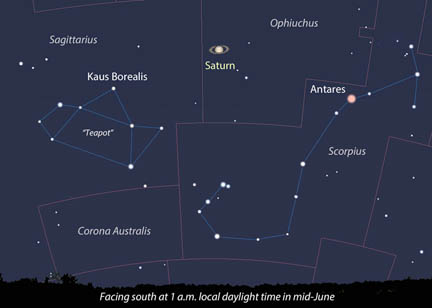
Stellarium
It happened again just last week. I was showing a group of people sky sights on a windy June night. Saturn had just cleared the trees, so I pointed my 10-inch Dob that way. "Yeah, I see it!" "Wow!" said a young woman when the ringed wonder greeted her eye.
Saturn's back and how glad we are that it is. It reaches opposition to the Sun tomorrow (June 15th) and spends all summer in the southern reaches of the constellation Ophiuchus, offering a perfect opportunity for sidewalk astronomers to mix their astronomy with a little astrology. The Sun, Moon, and planets spend nearly as much time here as in Cancer, another zodiacal constellation, begging the question as to why Ophiuchus couldn't be drafted into a modern astrology as the 13th sign. But I'm just making trouble!
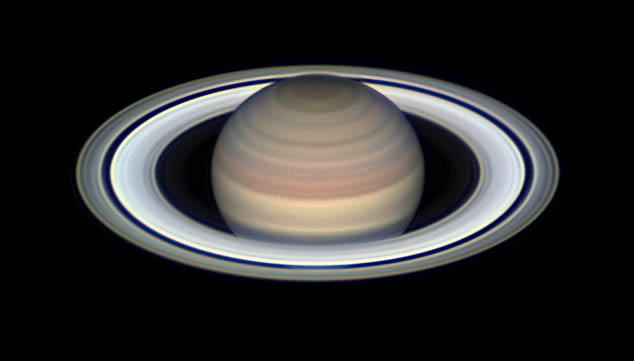
Christopher Go
At declination –22° south, Saturn hangs low in the southern sky for skywatchers at mid-northern latitudes this apparition. That means we should take every opportunity to observe the planet to increase our chances of catching it on a night of good seeing, the better to appreciate its arresting beauty and the subtleties of ring divisions, faint moons, and delicate cloud belts.
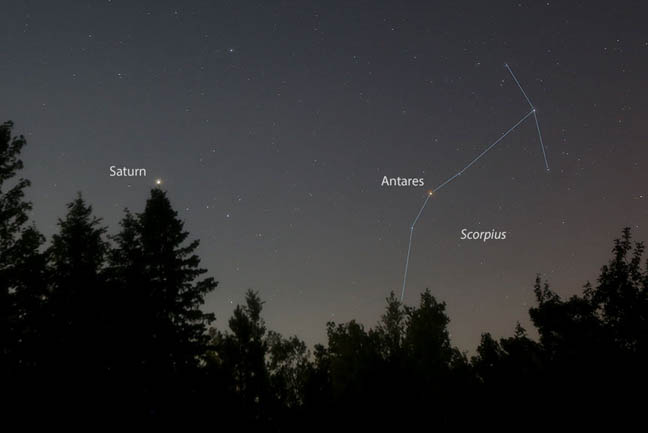
Bob King
Oh, those rings! It's summertime in Saturn's northern hemisphere, so we see their north face fully tipped into view, all of 26.6° at the moment. In October, they'll open to their maximum 27°. Amateurs can spot the three major rings — A, B, and C — even in telescopes as small as 4-inches. A-ring is the outermost and separated from B-ring, the brightest and widest, by the prominent dark gap called Cassini's Division.
The innermost C-ring begins along the inner edge of the B-ring and appears translucent compared to the solid-looking A- and B-rings; that's the reason it's also known as the Crepe Ring. Because the rings are tilted far forward, the Crepe Ring stands out plainly as a gray arc set against Saturn's bright disk (see photo diagram below). In calm air, you can also see it off to either side of the planet, tucked within the arc of the B-ring.
Ring lovers will find this opposition the best time to look for Cassini's Division, a hair-like gap separating the narrower A-ring from the broad, brighter B-ring. The gap is easiest to make out at the east and west extremities of the ring plane, known as the ansae, in a good 3-inch telescope. Use a magnification of 100× to 200× to see it best.
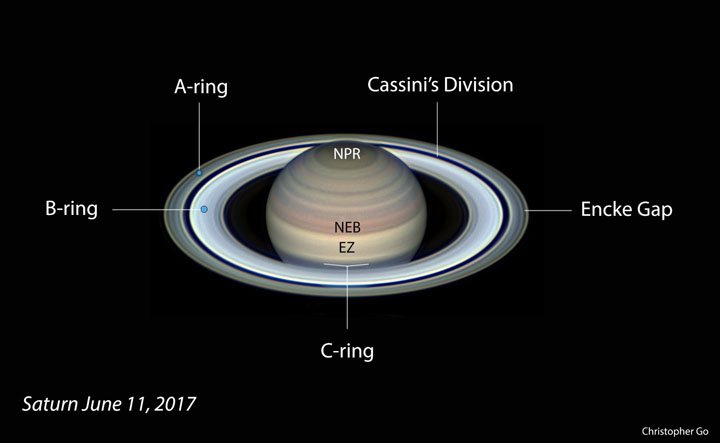
Christopher Go with labels by the author
In steady seeing, using a 6-inch or larger telescope you can almost follow Cassini's full circle around the planet. During a spell of calm air several nights ago, I discovered that the tippy-top of Saturn's globe notches out a small section of the much-foreshortened ring plane on the planet's backside. About ~8° is missing. Maybe early this fall, when the rings reach their maximum tilt, we'll be able to see the full 360°.
Tugs from the moon Mimas clear the 4,800 km (3,000 mile) wide Cassini's Division, while tiny Pan, which orbits within the A-ring, sweeps ring particles hither and thither to carve out the 325 km (202 mile) wide Encke Division, located about 80% of the way from the Cassini Division to the outer edge of the A-ring.
Observers using 10-inch telescopes in crystal sharp seeing have momentarily spotted this 0.35″ gap, and I've heard of at least one observation made with a 6-inch aperture. Me? Not yet, but it's definitely on my bucket list. Catching sight of the divide requires perfect seeing and the highest magnification that conditions will allow. Like Cassini's, it is most obvious in the outer ansae.
One of my favorite Saturn pastimes is comparing and contrasting the color and brightness of the planet vs. the rings. Made of billions of bits of reflective water ice ranging in size from tiny grains to large boulders, the A- and B-rings — particularly the latter — appear brilliant white with maybe a hint of yellow. If you study them for a few minutes and then shift your focus to the globe, it looks strikingly tan or even brown in comparison.
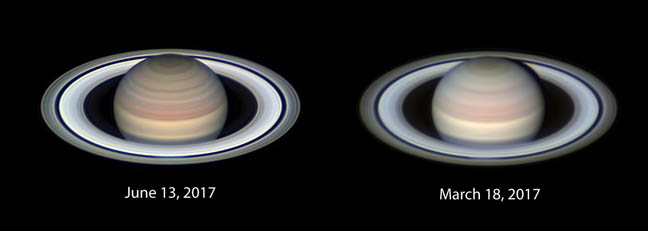
Christopher Go
The difference between rings and disk can be stark around the time of opposition due to the Seeliger Effect. At opposition, the Sun strikes the ring particles squarely from our perspective, so the shadows they cast are hidden behind their tiny bulks. Without shadows to ameliorate the light, the rings surge in brilliance. It's quite obvious at the moment. When you observe the planet, make a mental note of the rings' appearance and then compare the view to their appearance in a few weeks.

Stellarium
Like Jupiter, Saturn has a diverse family of moons. The brightest, largest and most atmospheric is Titan at magnitude +9. It seems no matter what scope you use or on what night you point to the planet, Titan's always nearby like a dog on a leash. 8-inch and larger telescopes will reveal the orange hue of its smoggy atmosphere. Next in brightness is Rhea (REE-uh) at magnitude +10.3, then Tethys (TEE-thiss) at +10.9, and finally Dione (dee-OH-Nee) at +11.0. All orbit interior to Titan and are visible in a 6-inch.
Joining the fab four, though fainter and orbiting even closer to the planet — and more affected by the glare from the maxed-out rings — is magnitude +11.4 Enceladus, a moon famous for its misty geysers and salt-water interior. An 8-inch will deliver this icy point of light to your eye. Be sure to use Sky & Telescope's interactive Saturn's Moons site so you know how to find all five any night of the year.
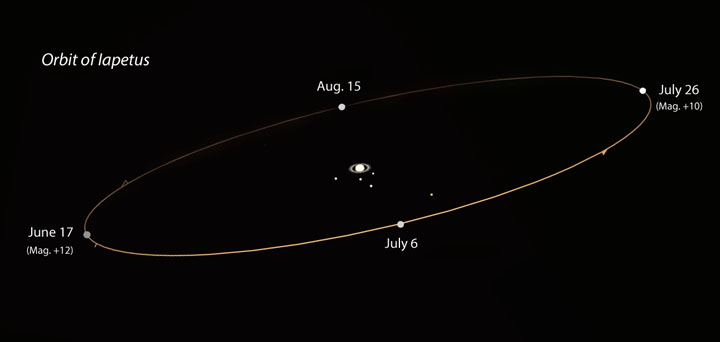
Source: Starry Night
Let's not forget the Jekyll and Hyde moon, Iapetus. With one side coated in coal-black organics and the other in bright ice, we see alternate faces as it swings around Saturn every 79 days. At western elongation, the icy side shines at +10.2 magnitude and becomes the planet's second brightest moon. But 6 weeks later at eastern elongation, it only manages magnitude +12. Not terribly faint, but the two-magnitude difference dramatically affects its appearance in small telescopes.
Two additional moons, Mimas and Hyperion, will tax a 12-inch scope. Mimas (magnitude +13.6) never gets farther than about one ring-plane width from the rings, making it a difficult catch in their glare. Hyperion orbits further out but at magnitude +14.9, you'll need a good chart to find it. Or an app. Check out SaturnMoons for iPhone from Sky & Telescope or Moons of Saturn for Android.
This year, both Saturn and Earth are seasonally in sync, with summer underway in both planets' northern hemispheres. Like soldiers at attention, the twin north polar axes tilt sunward in solidarity in salute of the season. Join the fun by tilting your telescope Saturn-ward the next clear night.
 18
18









Comments
June 15, 2017 at 7:59 am
Superb artikel! Lot's of useful info. Jakob
You must be logged in to post a comment.
Bob KingPost Author
June 15, 2017 at 4:19 pm
Danke vielmals, Jakob! Es freut mich, dass Sie die Artikel genossen haben.
You must be logged in to post a comment.
Tirth
September 27, 2017 at 11:49 am
"artlike"? It IS art. Where can I find an actual photo of a planet? Everything I can find on this site is cgi. I challenge someone to show me an actual photo of a planet that looks anything like these images. It will relieve a lot of stress if someone can meet this challenge.
You must be logged in to post a comment.
Bob KingPost Author
September 29, 2017 at 8:48 am
Hi Tirth,
All the photos used in the story are real photos of the planet taken by talented astrophotographers. The others are a map showing Iapetus' location and simulation (clearly noted) of Saturn and its moons on June 14.
You must be logged in to post a comment.
June 15, 2017 at 6:44 pm
Will I be seeing you in Casper, Wyoming during the eclipse? 😉
You must be logged in to post a comment.
Bob KingPost Author
June 15, 2017 at 8:32 pm
I will be not too far away in western Nebraska.
You must be logged in to post a comment.
Graham-Wolf
June 15, 2017 at 9:24 pm
Another great article Bob!
Saturn always holds fond memories for us old astronomers......
We always remember the first time we ever saw it at a local public observatory.
Mmmmmm.
Those rings... those rings... WOW! We were all "changed" forever!
Fast forward some 6 decades, and it's visual glory has not waned a bit.
As we all got more experienced and had access to better scopes, we soon located the Cassini Gap, Encke ring, the crepe ring, then looked out for polar outbursts/ storms.
100x became 200x, then 300, then 500x if you had access to a research grade RCT, say, a Boller and Chivens.
Then (to up the ante a bit) we all tried to find it's brighter Moons.
Iapetus was always a good challenge ~ Mv 12 in a 6 incher, I dimly recall...
Saturn just never failed to excite the viewer.
Those beautiful rings were always astro "eye-candy" for our nocturnal tired eyes.
In-between current observing runs on the brighter comets, here at 46 South, NZ, I've frequently ventured over across the sky towards Antares and had a glimpse at Saturn.
Ooooooh Ahhhhhh.
It's celestial charm is simply irresistable!
Rather like re-acquainting with an old dear friend.
Saturn.... it simply looks as gorgeous as ever!
Graham W. Wolf at 46 South, NZ.
You must be logged in to post a comment.
Bob KingPost Author
June 16, 2017 at 10:13 am
Graham-Wolf,
"Changed forever" I think describes how so many of us felt when we saw Saturn for the first time. Great description of your experience, Graham.
You must be logged in to post a comment.
Russ
June 16, 2017 at 3:31 am
Thanks again Bob, for a very good observing guide. Saturn will surely be on my agenda for the Golden State Star Party next week. No doubt the first view of Saturn has been the start of many an astronomer's lifelong love of the night sky. My first telescopic view of Saturn came in 1962. No turning back, now I'm hooked. With the rings wide open, it doesn't get much better than this year. Of course the southerly declination favors our "down under" friends.
I'm hoping to get at least one observing run on Saturn with my C-11 and ZWO AS290MC video camera. Since it will be just under 27 degrees elevation (at most) I'll be using my ZWO Atmospheric Dispersion Corrector to tame the color fringing.
With the solar eclipse, this is an exciting year for us astronomers. I hope traffic won't be too bad. I'm staying at an Oregon State park near Madras, Oregon. It's coming up fast!
You must be logged in to post a comment.
Bob KingPost Author
June 16, 2017 at 10:15 am
Rusty,
Thanks! A great summer it will be between Saturn, the eclipse and the best of the Milky Way.
You must be logged in to post a comment.
Marlon-Arciga
June 17, 2017 at 7:25 am
Thanks for the great article! Is Titan visible through 50mm binoculars?
You must be logged in to post a comment.
Bob KingPost Author
June 17, 2017 at 10:03 am
Hi Marlon,
Thanks! While 9th magnitude stars are visible in binoculars under dark skies, Titan would be a great challenge because at 10x (for instance) it would be so close to Saturn and lost in its glare. Still, it might be worth trying. Use the Saturn's moons link to find out when Titan is at greatest elongation from the planet, then place your binoculars on a sturdy tripod, focus precisely and see what you might see.
You must be logged in to post a comment.
Anthony Barreiro
June 19, 2017 at 2:35 pm
Saturn is so far south this year that I can't get a decent telescopic view from my backyard. But even peeking through trees and buildings, Saturn was noticeably brighter for the few nights right around opposition.
Saturday night I went to Chabot Observatory in Oakland and saw Saturn through Leah, an 8-inch refractor built by Alvan Clark and Sons in 1883, and in continuous use at Chabot since then. It was a lovely clear night with decent seeing. A, B, and C rings, Cassini division, banding on Saturn's surface, Titan, Rhea, Dione, and Tethys were all visible, although Dione and Tethys were quite faint.
You must be logged in to post a comment.
June 19, 2017 at 3:47 pm
Is it possible to visit Chabot observatory and you Anthony beeing the guide. Last two days of August? 🙂 J
You must be logged in to post a comment.
Anthony Barreiro
June 19, 2017 at 5:36 pm
Jakob -- Chabot Observatory is open to the public most every Friday and Saturday night. Check the website to make sure they'll be open: http://www.chabotspace.org/observatories.htm
All the volunteers are very welcoming, and great guides.
You must be logged in to post a comment.
June 20, 2017 at 7:18 am
Thanks for your reply Anthony! J
You must be logged in to post a comment.
Bob KingPost Author
June 19, 2017 at 4:46 pm
Hi Anthony,
I've got the same southern issues, the reason I look at Saturn as often as possible. I did get a fantastic night a week ago. Just amazingly sharp. Your view at the observatory sounds great.
You must be logged in to post a comment.
Graham-Wolf
June 22, 2017 at 9:29 pm
Hello Bob
Sad to report the passing of a much respected astro-friend/peer/mentor:- Prof Michael A'Hearn on May 29th (3 days after my own birthday) at only 76 years of age. Was recently notified by my UK (T.A.) colleagues, this week, from Basingstoke.
I first met Michael in the mid 1980's, during the "warm-up" to the p/1 Halley season. I was already some 3 years into the IHW project. Local Dave J. Curtis and I had just secure NZ's first astro-image of P/1 with an 8 inch f5 and Hypered 2415 film. Shortly afterward, we meet Michael at Dunedin's Hutton Theatre to a packed audience in NZ. He was clearly impressed with our MLim 16 images! Michael got a standing ovation that evening for his presentation on Comets... particularly on p/1 Halley. It was mostly Steve Edberg and Michael A'Hearn who inspired me to later become a full-time astronomer at my nation's National Observatory in Wellington. I remember Michael as a really kind, affable and engaging guy, who freely shared his enormous knowledge with others. He also had a dry sense of humour... always welcome in NZ. Throughout his NZ tour, I never heard a single bad word ever said about him. Michael was amused to find that the equatorial constellations were "upside down, and back-to-front" from what he was used to, back home.He couldn't stop raving about our dark southern skies! Michael was also a keen fan of the 3.9m AAT at Siding Springs. A "semi-Hale-scope" he affectionally referred to it as.
Michael had a Minor Planet named after him (3192 A'Hearn) in June 1986. He also was awarded the prestigious Kuiper Prize in 2008. He was additionally the Principal Scientific Investigator (PSI) for NASA's EXPOXI Mission.
He will be sadly missed.
Graham W. Wolf at 46 South, NZ.
You must be logged in to post a comment.
You must be logged in to post a comment.